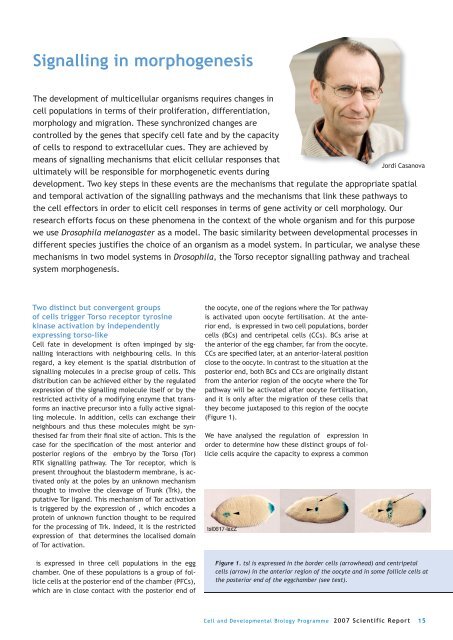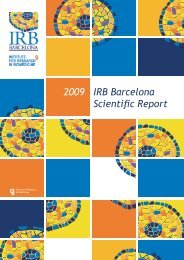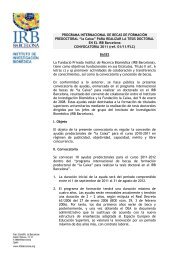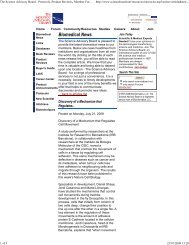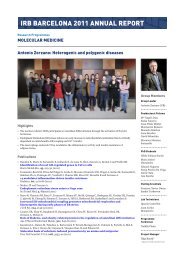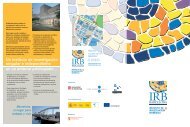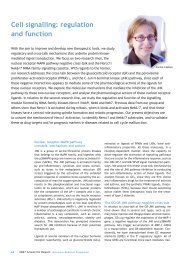Signalling in morphogenesis - IRB Barcelona
Signalling in morphogenesis - IRB Barcelona
Signalling in morphogenesis - IRB Barcelona
Create successful ePaper yourself
Turn your PDF publications into a flip-book with our unique Google optimized e-Paper software.
<strong>Signall<strong>in</strong>g</strong> <strong>in</strong> <strong>morphogenesis</strong><br />
The development of multicellular organisms requires changes <strong>in</strong><br />
cell populations <strong>in</strong> terms of their proliferation, differentiation,<br />
morphology and migration. These synchronized changes are<br />
controlled by the genes that specify cell fate and by the capacity<br />
of cells to respond to extracellular cues. They are achieved by<br />
means of signall<strong>in</strong>g mechanisms that elicit cellular responses that<br />
ultimately will be responsible for morphogenetic events dur<strong>in</strong>g<br />
Jordi Casanova<br />
development. Two key steps <strong>in</strong> these events are the mechanisms that regulate the appropriate spatial<br />
and temporal activation of the signall<strong>in</strong>g pathways and the mechanisms that l<strong>in</strong>k these pathways to<br />
the cell effectors <strong>in</strong> order to elicit cell responses <strong>in</strong> terms of gene activity or cell morphology. Our<br />
research efforts focus on these phenomena <strong>in</strong> the context of the whole organism and for this purpose<br />
we use Drosophila melanogaster as a model. The basic similarity between developmental processes <strong>in</strong><br />
different species justifies the choice of an organism as a model system. In particular, we analyse these<br />
mechanisms <strong>in</strong> two model systems <strong>in</strong> Drosophila, the Torso receptor signall<strong>in</strong>g pathway and tracheal<br />
system <strong>morphogenesis</strong>.<br />
Two dist<strong>in</strong>ct but convergent groups<br />
of cells trigger Torso receptor tyros<strong>in</strong>e<br />
k<strong>in</strong>ase activation by <strong>in</strong>dependently<br />
express<strong>in</strong>g torso-like<br />
Cell fate <strong>in</strong> development is often imp<strong>in</strong>ged by signall<strong>in</strong>g<br />
<strong>in</strong>teractions with neighbour<strong>in</strong>g cells. In this<br />
regard, a key element is the spatial distribution of<br />
signall<strong>in</strong>g molecules <strong>in</strong> a precise group of cells. This<br />
distribution can be achieved either by the regulated<br />
expression of the signall<strong>in</strong>g molecule itself or by the<br />
restricted activity of a modify<strong>in</strong>g enzyme that transforms<br />
an <strong>in</strong>active precursor <strong>in</strong>to a fully active signall<strong>in</strong>g<br />
molecule. In addition, cells can exchange their<br />
neighbours and thus these molecules might be synthesised<br />
far from their f<strong>in</strong>al site of action. This is the<br />
case for the specification of the most anterior and<br />
posterior regions of the embryo by the Torso (Tor)<br />
RTK signall<strong>in</strong>g pathway. The Tor receptor, which is<br />
present throughout the blastoderm membrane, is activated<br />
only at the poles by an unknown mechanism<br />
thought to <strong>in</strong>volve the cleavage of Trunk (Trk), the<br />
putative Tor ligand. This mechanism of Tor activation<br />
is triggered by the expression of , which encodes a<br />
prote<strong>in</strong> of unknown function thought to be required<br />
for the process<strong>in</strong>g of Trk. Indeed, it is the restricted<br />
expression of that determ<strong>in</strong>es the localised doma<strong>in</strong><br />
of Tor activation.<br />
the oocyte, one of the regions where the Tor pathway<br />
is activated upon oocyte fertilisation. At the anterior<br />
end, is expressed <strong>in</strong> two cell populations, border<br />
cells (BCs) and centripetal cells (CCs). BCs arise at<br />
the anterior of the egg chamber, far from the oocyte.<br />
CCs are specified later, at an anterior-lateral position<br />
close to the oocyte. In contrast to the situation at the<br />
posterior end, both BCs and CCs are orig<strong>in</strong>ally distant<br />
from the anterior region of the oocyte where the Tor<br />
pathway will be activated after oocyte fertilisation,<br />
and it is only after the migration of these cells that<br />
they become juxtaposed to this region of the oocyte<br />
(Figure 1).<br />
We have analysed the regulation of expression <strong>in</strong><br />
order to determ<strong>in</strong>e how these dist<strong>in</strong>ct groups of follicle<br />
cells acquire the capacity to express a common<br />
is expressed <strong>in</strong> three cell populations <strong>in</strong> the egg<br />
chamber. One of these populations is a group of follicle<br />
cells at the posterior end of the chamber (PFCs),<br />
which are <strong>in</strong> close contact with the posterior end of<br />
Figure 1. tsl is expressed <strong>in</strong> the border cells (arrowhead) and centripetal<br />
cells (arrow) <strong>in</strong> the anterior region of the oocyte and <strong>in</strong> some follicle cells at<br />
the posterior end of the eggchamber (see text).<br />
Cell and Developmental Biology Programme 2007 Scientific Report<br />
15
Research Group Members I Pr<strong>in</strong>cipal Investigator: Jordi Casanova I<br />
Associate Researchers: Andreu Casali, Marc Furriols I Postdoctoral Fellows:<br />
Sofia Araújo, Louis Gervais, Daniel Shaye I PhD Students: José de las Heras,<br />
Gemma Ventura I Research Assistant: Nicolás Martín I Lab Technicians:<br />
Raquel Méndez, Núria Molist I Visitor: Myrto Deligiannaki (Greece)<br />
signall<strong>in</strong>g factor. We have found that JAK/STAT signall<strong>in</strong>g,<br />
which is responsible for <strong>in</strong>itially pattern<strong>in</strong>g the<br />
egg chamber epithelium, also regulates expression <strong>in</strong><br />
PFCs and BCs. However, this pathway does not regulate<br />
expression <strong>in</strong> CCs, which, <strong>in</strong> these cells, is regulated<br />
by a different enhancer. We have also exam<strong>in</strong>ed<br />
the functional significance of expression <strong>in</strong> BCs and<br />
CCs, and have found that both cell groups contribute<br />
to trigger Tor activation <strong>in</strong> the anterior embryonic<br />
region. Our results illustrate how <strong>in</strong>dependently<br />
acquired expression of a signall<strong>in</strong>g molecule <strong>in</strong> dist<strong>in</strong>ct<br />
group of cells constitutes a mechanism by which<br />
these cells act together <strong>in</strong> the activation of a signall<strong>in</strong>g<br />
pathway.<br />
<strong>Signall<strong>in</strong>g</strong> and cytoskeleton organisation<br />
<strong>in</strong> tracheal <strong>morphogenesis</strong><br />
We address the l<strong>in</strong>k between signall<strong>in</strong>g and cytoskeleton<br />
by exam<strong>in</strong><strong>in</strong>g the mechanisms <strong>in</strong>volved <strong>in</strong> tracheal<br />
<strong>morphogenesis</strong>. To this end, we are undertak<strong>in</strong>g<br />
a complete description of tracheal <strong>morphogenesis</strong> at<br />
the cellular level to analyse the contribution of cytoskeleton<br />
elements and cell organelles to this process<br />
and to establish the changes <strong>in</strong> these elements<br />
that are under the control of signall<strong>in</strong>g pathways and<br />
the mechanisms <strong>in</strong>volved <strong>in</strong> this control.<br />
Figure 2. The embryonic tracheal system of Drosophila is a complex tubular<br />
network that arises from sets of ectodermal cells that <strong>in</strong>vag<strong>in</strong>ate and migrate<br />
<strong>in</strong> stereotyped and dist<strong>in</strong>ct directions to form each of the primary tracheal<br />
branches. In red the tracheal lumen, <strong>in</strong> green the tracheal cells.<br />
The tracheal system of is a complex tubular network<br />
that conducts oxygen from outside the organism to<br />
<strong>in</strong>ternal tissues. This network arises from the tracheal<br />
placodes, clusters of ectodermal cells at each<br />
side of 10 embryonic segments from the 2 nd thoracic<br />
segment to the 8 th abdom<strong>in</strong>al segment. Tracheal cells<br />
are specified by the activity of a set of genes whose<br />
expression <strong>in</strong> these cells is regulated by the genes<br />
16 2007 Scientific Report Cell and Developmental Biology Programme
that specify positional cues along the embryonic body<br />
axes. Cells of each cluster <strong>in</strong>vag<strong>in</strong>ate and migrate <strong>in</strong><br />
stereotyped and dist<strong>in</strong>ct directions to form each of<br />
the primary tracheal branches. The general conclusion<br />
from many studies is that the migratory direction<br />
of tracheal cells relies on a set of positional signals<br />
provided by nearby cells. In addition, the establishment<br />
of <strong>in</strong>teractions between tracheal cells and their<br />
substrates is a crucial step <strong>in</strong> tracheal cell migration,<br />
a process ultimately determ<strong>in</strong>ed by molecules expressed<br />
at their surface (Figure 2).<br />
In this context, <strong>in</strong> collaboration with Marta Llimargas’<br />
group at the IBMB (CSIC), Sofia Araújo has been<br />
study<strong>in</strong>g the role of the transcription factor Tramtrack<br />
(Ttk) <strong>in</strong> the development of the tracheal system.<br />
They have found that, <strong>in</strong> addition to a role <strong>in</strong><br />
the specification of dist<strong>in</strong>ct tracheal cell identities,<br />
Ttk is directly <strong>in</strong>volved and required for a range of<br />
cellular responses and morphogenetic events. In particular,<br />
Ttk appears to be a new positive regulator<br />
of tracheal cell <strong>in</strong>tercalation. Analysis of this process<br />
<strong>in</strong> mutants has unveiled cell shape changes as a key<br />
requirement for <strong>in</strong>tercalation and has identified Ttk<br />
as a novel regulator of its progression. In addition,<br />
Ttk is also a regulator of <strong>in</strong>tracellular lumen formation<br />
and is autonomously <strong>in</strong>volved <strong>in</strong> the control of<br />
tracheal tube size by regulat<strong>in</strong>g septate junction activity<br />
and cuticle formation. In summary, Ttk governs<br />
tracheal development by act<strong>in</strong>g on the regulation of<br />
sequential steps of tube <strong>morphogenesis</strong>.<br />
Publications<br />
Araújo S, Cela C and Llimargas M. Tramtrack regulates<br />
different morphogenetic events dur<strong>in</strong>g Drosophila tracheal<br />
development. Development, 134, 3665-76 (2007)<br />
Casanova J. The emergence of shape: notions from the study<br />
of the Drosophila tracheal system. EMBO Rep, 8, 335–39<br />
(2007)<br />
Furriols M, Ventura G and Casanova J. Two dist<strong>in</strong>ct but<br />
convergent groups of cells trigger Torso receptor tyros<strong>in</strong>e<br />
k<strong>in</strong>ase activation by <strong>in</strong>dependently express<strong>in</strong>g torso-like.<br />
Proc Natl Acad Sci USA, 104, 11660–65 (2007)<br />
Research Networks and Grants<br />
Ajut per a grups de recerca s<strong>in</strong>gular<br />
Generalitat de Catalunya, SGR2005-00508: 2005-2008<br />
Research Director: Jordi Casanova<br />
Mecanismos de señalización celular y morfogénesis en el<br />
desarrollo de Drosophila<br />
M<strong>in</strong>isterio de Educación y Ciencia, BFU2006-01935/BMC:<br />
2006-2009<br />
Research Director: Jordi Casanova<br />
Collaborations<br />
Analysis of Drosophila tracheal development<br />
Marta Llimargas, IBMB-CSIC (<strong>Barcelona</strong>, Spa<strong>in</strong>)<br />
Interaction between germ-cell determ<strong>in</strong>ants and Torso RTK<br />
signall<strong>in</strong>g <strong>in</strong> Drosophila<br />
Ruth Lehmann, Skirball Institute (New York, USA) and Rui<br />
Mart<strong>in</strong>ho, Instituto Gulbenkian de Ciência (Oeiras, Portugal)<br />
On the orig<strong>in</strong> of <strong>in</strong>sect tracheal systems<br />
Michalis Averof, IMBB (Crete, Greece)<br />
Cell and Developmental Biology Programme 2007 Scientific Report<br />
17


